Houzz Tour: A Stunning Makeover Celebrates Warm Wood and Artful Salvage
http://decor-ideas.org 02/26/2014 01:22 Decor Ideas
When designers Chris McCullough and Peggy Hsu bought this Spanish colonial bungalow, they wanted a project. In Mar Vista, a small community east of Venice Beach, Los Angeles, these homes sell quickly, so when they came upon a quaint fixer-upper with great natural light on a corner lot, they went for it.
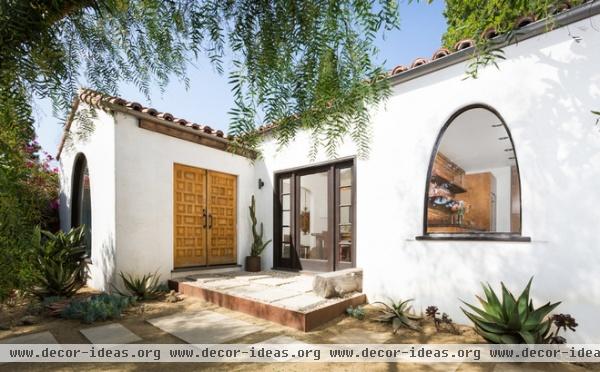
Houzz at a Glance
Who lives here: Peggy Hsu, Chris McCullough and Izzy Pop, their Wire Fox Terrier
Location: Mar Vista neighborhood of Los Angeles
Designer: Hsu McCullough
Size: Main house: 1,140 square feet (106 square meters); 2 bedrooms, 1½ bathrooms; detached garage: 350 square feet (33 square meters)
Year remodeled: 2007 to 2009; the landscape was finished in 2013
That’s interesting: When Hsu and McCullough were remodeling, they discovered a copy of the Los Angeles Times from 1930 in the walls.
Photography by Clark Dugger
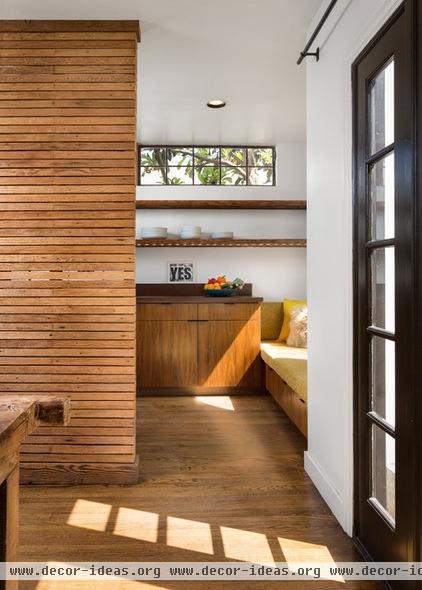
The previous owner had been renting out the house since the 1980s. Hsu and McCullough stripped all evidence of that era in favor of more timeless updates. Structurally the house was in great shape, so it was a pretty straightforward remodel and demolition process.
The couple reused, repurposed and salvaged materials when they could. In addition to adding a worn-in richness, it saved them money. They bought things that weren’t in pristine condition and restored them. They also helped with the construction work.
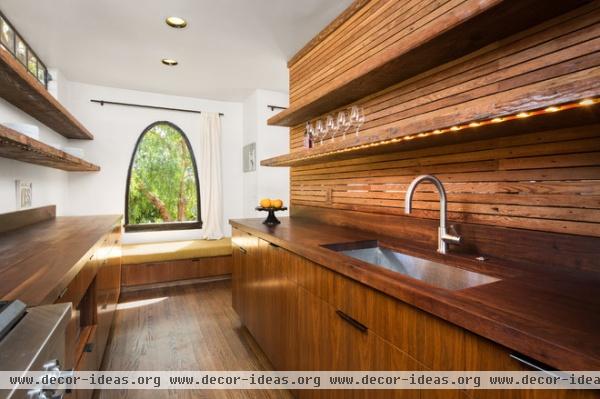
McCullough once worked at an architecture firm in Osaka, Japan, and while he was there, he saw how fearlessly designers mixed and matched wood types. He took the idea with him — in this house you can see some instances where five types of wood are being used at once.
The galley kitchen is a study in wood. All the wood colors and tones are similar but not too matchy. Hsu and McCullough chose solid American black walnut for the countertops. It complemented the other materials used in the house, it was comparably priced to the other materials that they were interested in, and they looked forward to how it would evolve over time. The cabinets are a lighter stained walnut veneer. McCullough salvaged the open wall shelves from another project.
The solid oak floors are original to the house. Carpeting covered them during the home’s rental years, preserving them fairly well. New flooring was pieced in where walls were moved, and all the floors were sanded and refinished for continuity.
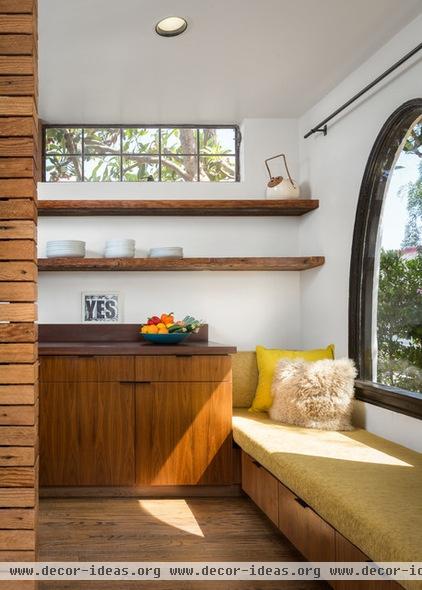
The window seat off the kitchen is one of McCullough’s favorite spaces.
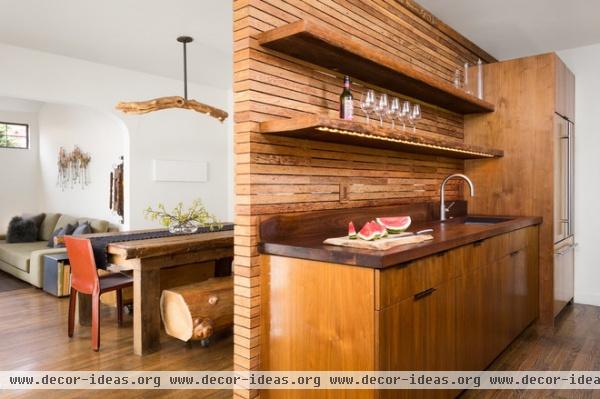
With the exception of some casual advice offered to friends, this was Hsu and McCullough’s first project together. Though McCullough says he and Hsu were on the same page about most of the bigger decisions, there were some instances where their visions deviated and compromises were necessary.
For example, McCullough wanted to completely open up the kitchen, dining and living areas to one another. Hsu wanted to keep the kitchen closed, as kitchens traditionally were closed off when the house was built, and to preserve the original scale of the rooms. They resolved this by creating a semitransparent wood wall panel between the kitchen and the dining room. Both rooms remain separate, but light and a hint of movement flow between the two spaces.
Much of the wood used in the project, including the wall in the kitchen, came from the framing of walls they removed. McCullough cleaned much of the salvaged wood framing and lath with a drill-powered wire wheel, revealing a warm and textured finish.
He suggests wood as a good material for anyone who wants to be crafty with a home improvement project. It is easy to manipulate, he says.
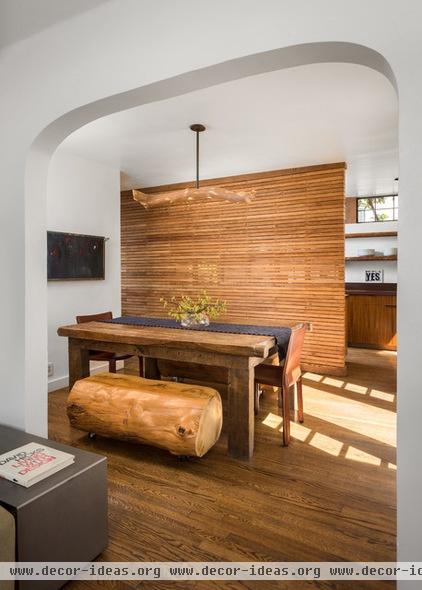
The dining room meets the other side of the wood partition. The light fixture above the dining table is a custom piece McCullough devised from a sycamore tree branch.
After the piece was wired by an electrician, he inserted five LEDs and a remote transformer into the branch. A black iron gas pipe and an old weight found during the remodel connect the fixture to the ceiling. McCullough says the whole thing probably cost around $300.
A similar story accompanies the dining benches. Again, McCullough came across a mature pine tree that had been cut down. The trunk had been nicely divided into 5-foot sections so that it could be fed into a chipper. After packing four trunk sections into his truck, McCullough found a contractor who specialized in log cabin homes to mill the trunks, planing the top and bottom sides of the trunk to create flat surfaces. He let them dry out in the shade for a year before bringing them back inside and adding casters to the bottom.
The dining table came from a now-closed store (Casa Sweet Casa); it was made from repurposed mesquite wood gates.
Dining chairs: Cab-412 chairs in Russian Red Leather, Cassina
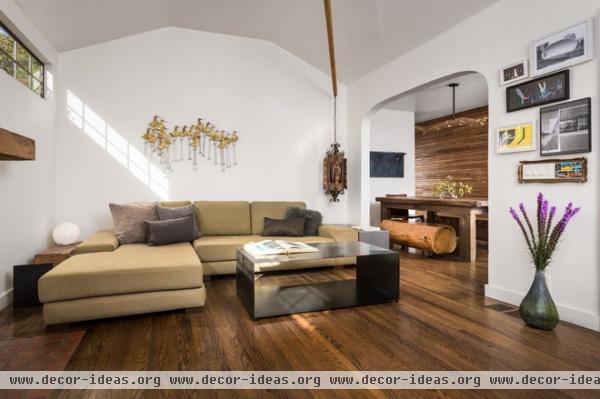
The living room sits just off the dining room. Hsu and McCullough bought the matching pair of lanterns at a salvage yard. A 20-foot-long wood handrail wrapped in sisal connects the lanterns to electrical wiring in the center of the ceiling.
Both the coffee table and side table are made from folded steel. The brass sandpiper wall sculpture is a 1960s Curtis Jeré piece they bought in Palm Springs, California.
Sofa: Viesso
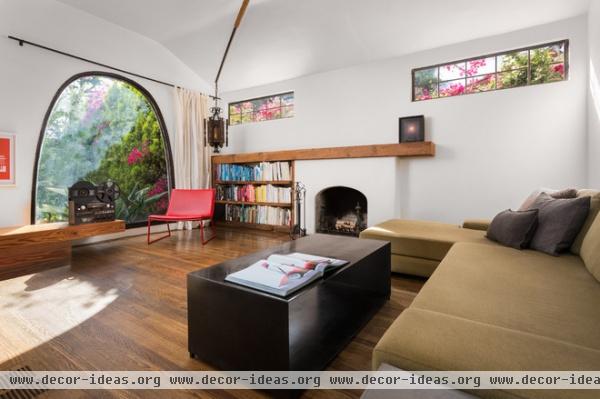
Here we see the other arm of the light fixture.
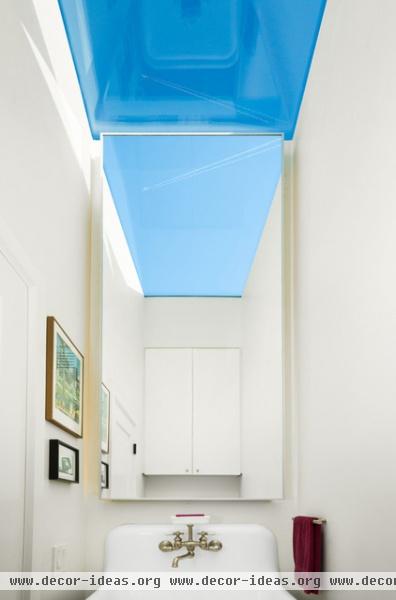
An oversize skylight provides a glimpse of what’s happening outside in the otherwise windowless powder room. The nearby Santa Monica airport provides a steady stream of visual stimulation, and a large backlit Ikea mirror is positioned to reflect the aerial action.
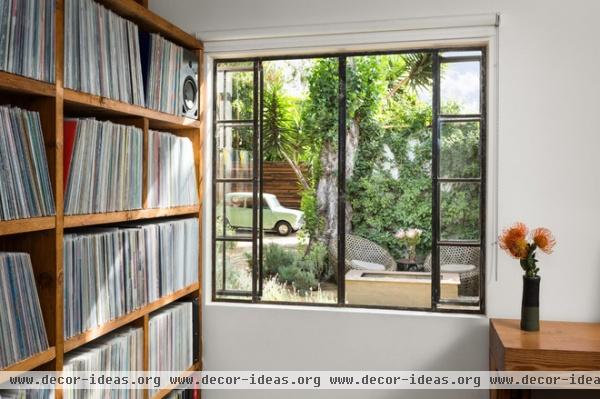
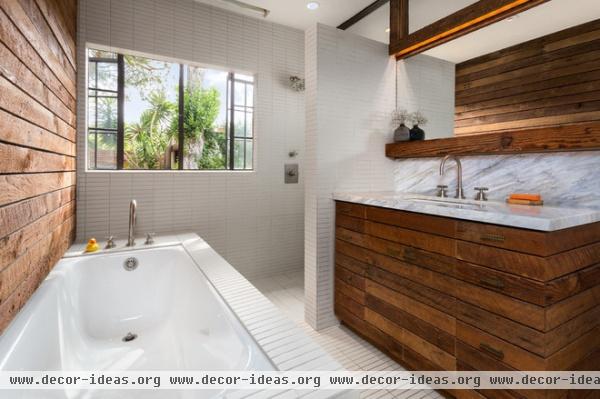
When they removed the floor in the bathroom, the couple discovered remnants of black, pink and turquoise tile from the original bathroom in the crawlspace. They decided not to restore the brilliant colors of the 1930s, instead opting for a warmer, stripped-down finish.
The textured wood vanity is made from more framing pieces from the house, and the countertop and backsplash are luxe Calacatta gold marble. ”We like the texture of wood,” says McCullough. The grain, surface and color can warm up a home.
Bathroom tile: Eco-Gres, Coverings Etc.
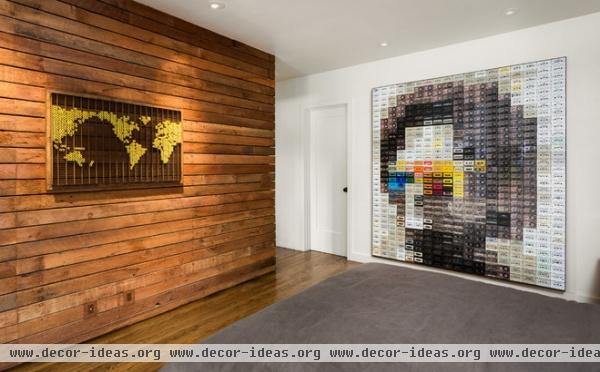
McCullough created both art pieces in the master bedroom. On the right wall hangs “Cassette James Brown.” Most of the tapes came from a local thrift store that was going out of business. He mounted them onto a piece of plywood through the voids in the cassette wheels. The entire piece is attached to the wall by a French cleat.
On the left wall hangs an abstract world map piece that McCullough made using the original floor heater from the house. The continents were made using electrical wire connectors. The wood accent wall features more timber salvaged from the selective demolition of interior walls.
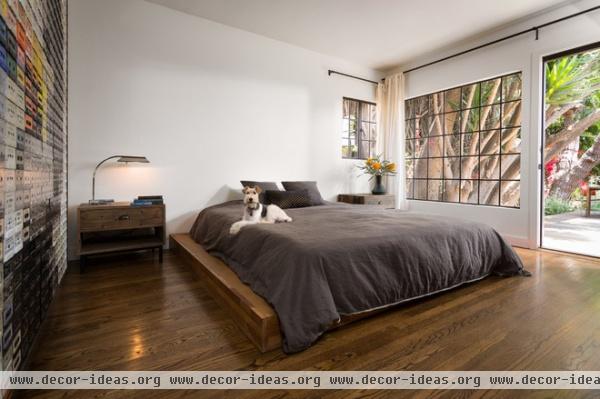
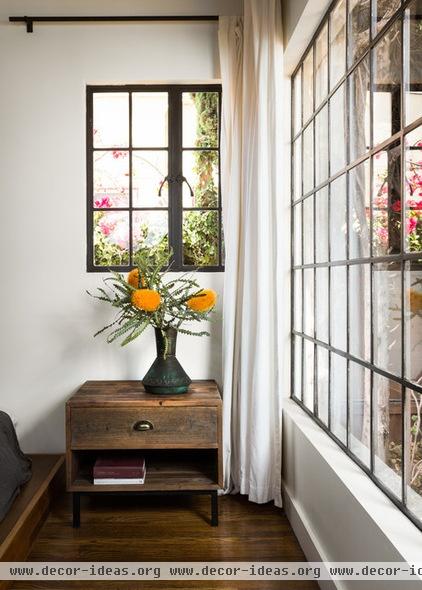
Here we see Izzy Pop, the couple’s Wire Fox Terrier, relaxing in the master bedroom. The wood bed platform is from MASHstudios’ LAXseries, and the bedside table is from Urban Home.
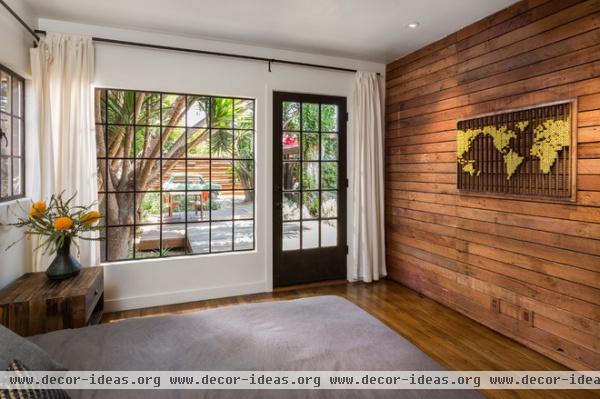
A new door leads out to the backyard. The couple says they wish they had added more doors to the backyard. In Southern California you can spend all year outside; just looking at the yard isn’t enough.
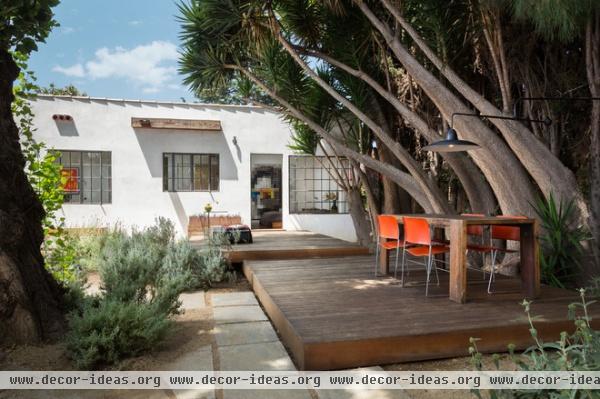
The landscape renovation happened a couple of years after the house’s makeover. After two years of construction, during which the couple lived in the house, they just wanted to enjoy their new home for a while.
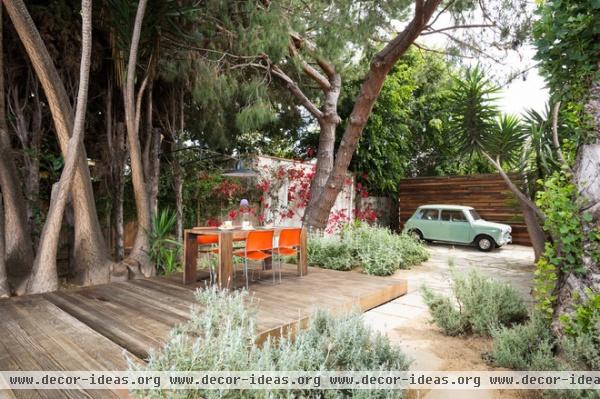
The outdoor dining chairs came from a used-furniture store; the couple built the dining table from leftover wood.
The mature yucca trees on the property were a selling point for the couple. They planted various Southern California–friendly plants in the backyard, including an olive tree and a pepper tree. French and Spanish lavenders surround the deck, and Jerusalem sage is planted near the driveway. A honeysuckle vine climbs up behind the fire pit.
Festoon String Lights, Architectural Boom Sconce: Restoration Hardware
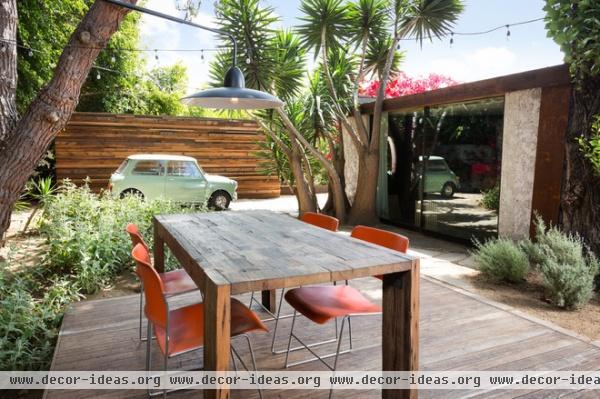
The wood wall beside the driveway conceals the home’s utility items and is made entirely from leftover wood. The owners carefully wove the pieces together and then heavily oiled the wood.
The detached garage serves a variety of purposes — McCullough recalls a party where Hsu’s band played there.
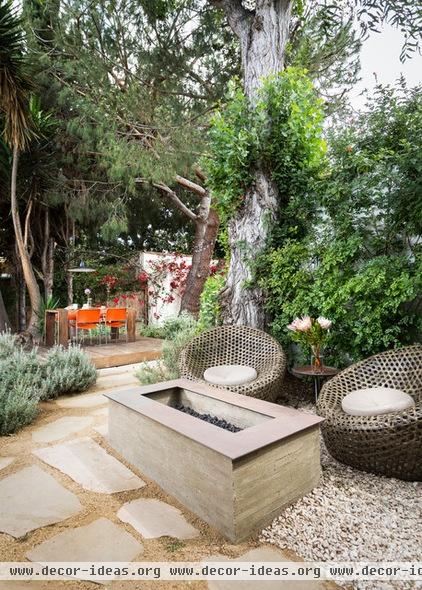
Various types of gravel and decomposed granite were used for the hardscaping. The driveway includes broken concrete picked up from Craigslist, and the flagstone is Santa Fe Buff.
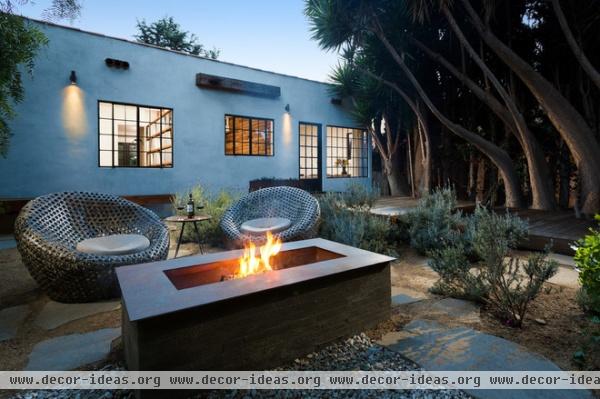
The fire pit was the final backyard project. The couple had intended to purchase a self-contained fire pit but realized there weren’t many that fit the look and price they wanted. So they had a board-formed concrete pit poured and topped it with ⅜-inch-thick cold-rolled steel.
Fireplace cap: prepared by Banks Welding in Los Angeles
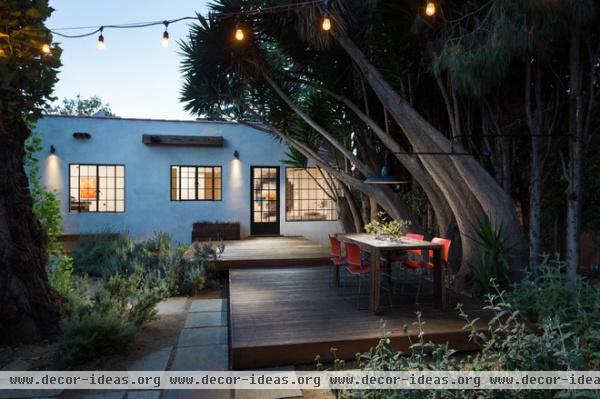
For now the house is done, but ideas for the architecture are never-ending. What’s next? McCullough says they may add a second story or just sell the house and begin again.
See the details of the transformation below.

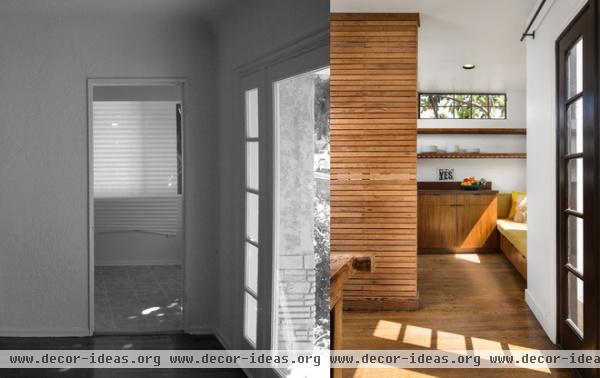
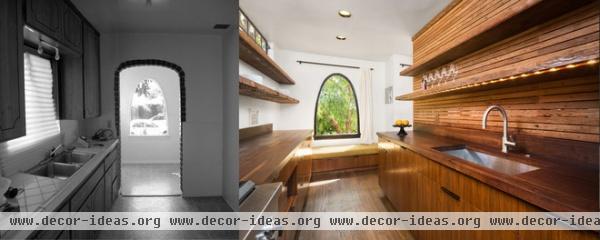
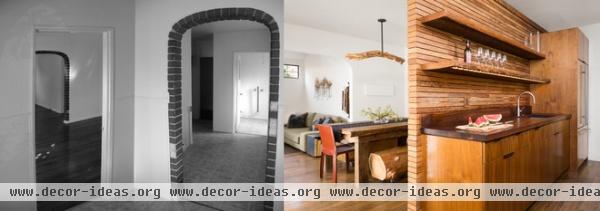
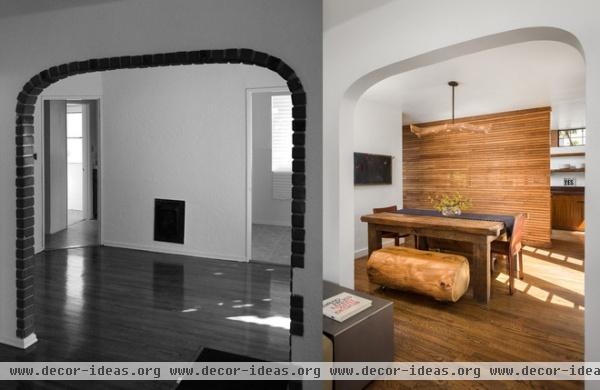

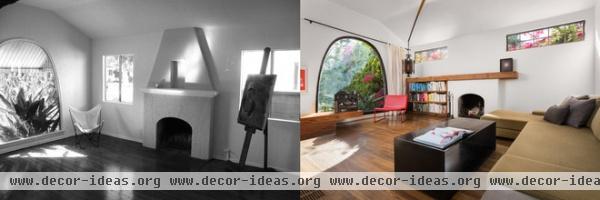


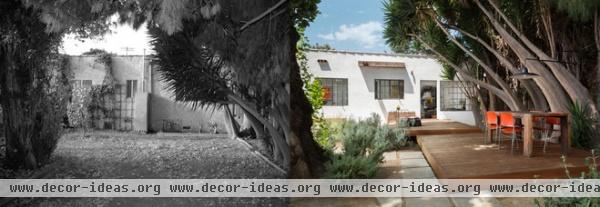
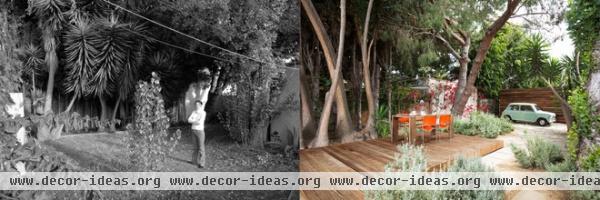
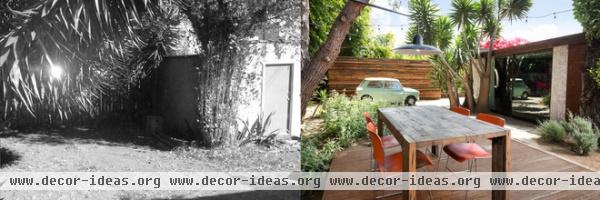
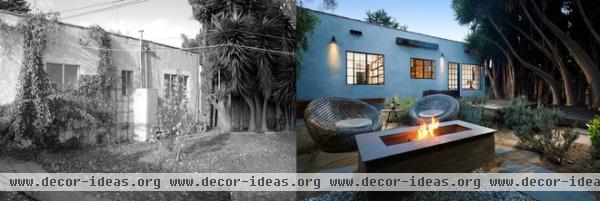
Related Articles Recommended












